Understanding the unique needs of children with Autism Spectrum Disorder (ASD) is so important for effective intervention. 🌟 When we personalize behavioral reinforcement strategies, we can really help a child thrive socially and emotionally. But let’s be honest - many caregivers struggle with picking the right techniques and keeping things consistent.
So, how can parents and educators navigate this complex landscape? It’s all about fostering positive behaviors and supporting your child's development. Let’s explore this together! We’re here to help you every step of the way!
At Rori Behavioral Innovations Inc., we understand that every child is unique, and that’s why we take a data-driven approach to Applied Behavior Analysis (ABA) therapy. Our goal is to utilize behavioral reinforcement strategies for kids with ASD to ensure that your little one’s individual needs are met through behavioral reinforcement strategies for kids with ASD that are personalized. By conducting thorough assessments, our clinicians craft customized treatment plans that focus on specific actions and abilities, helping your child gain the essential skills they need to navigate the world independently.
This tailored approach not only boosts your child’s ability to handle social situations but also fosters greater independence and integration into their communities. Research shows that early and consistent intervention can lead to significant improvements in communication and adaptive behaviors. Many young individuals often show remarkable progress in their social skills and overall development.
We’re committed to customizing therapy so that each child receives the support they need to thrive. This reflects the incredible potential of personalized ABA strategies in autism care. With active caregiver participation and insurance support, we’re proud to promote substantial advancements in 90% of youth. It’s a testament to the importance of caregiver education in this journey.
Let’s explore this together! We’re here to help you every step of the way!
Positive reinforcement methods are all about celebrating those little victories! 🎉 When kids do something great, like sharing their toys, offering instant rewards - think verbal praise, fun tokens, or even access to their favorite activities - can really make a difference. This approach, rooted in Applied Behavior Analysis (ABA), utilizes behavioral reinforcement strategies for kids with ASD to help them repeat positive actions while also boosting their self-esteem and motivation.
Imagine complimenting your child for sharing their toys; that simple act can strengthen their desire to share again in the future. By tailoring these strategies to fit each child's unique needs, ABA therapy becomes even more effective. And let’s not forget about early intensive behavioral intervention (EIBI)! It plays a crucial role in highlighting how behavioral reinforcement strategies for kids with ASD can enhance learning, communication, and social skills.
So, let’s explore this together! If you’re a parent navigating these challenges, remember that you’re not alone. We’re here to help you every step of the way!
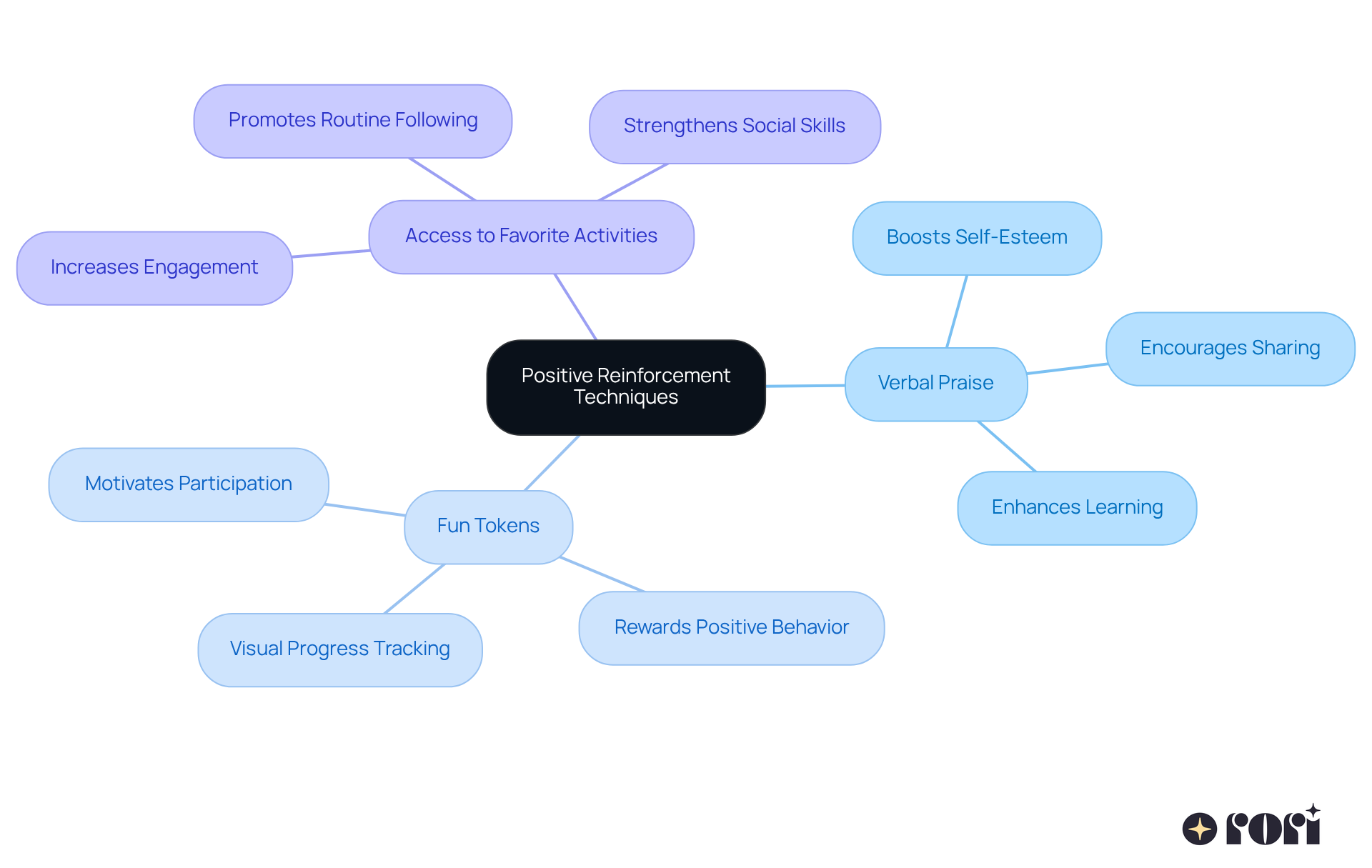
Have you ever wondered how to encourage positive behavior in kids? A token economy system might just be one of the effective behavioral reinforcement strategies for kids with ASD! This effective strategy is one of the behavioral reinforcement strategies for kids with ASD, rewarding children with tokens for showing desired behaviors, which they can later trade for fun rewards. It’s a fantastic way to inspire young ones and help them understand how their actions lead to rewards.
For instance, imagine a child earning a token for finishing their homework. They can then exchange that token for extra playtime! This approach not only promotes good behavior but also teaches kids the valuable skill of delayed gratification - waiting for a reward instead of seeking instant satisfaction.
Research backs this up, too! In a study with youth in orphanages, behavioral scores improved dramatically after implementing a token economy, dropping from 34.42 to 16.34. That’s a huge difference! Plus, Board Certified Behavior Analysts (BCBAs) emphasize that implementing behavioral reinforcement strategies for kids with ASD, such as organized rewards, helps children understand expectations and consequences better, leading to improved emotional and social development.
Before the intervention, 76% of children faced moderate behavioral challenges, highlighting how crucial behavioral reinforcement strategies for kids with ASD can be in addressing significant issues. And let’s not forget the role of caregivers! Their active involvement in these strategies, along with careful data collection, really boosts the effectiveness of the intervention.
So, if you’re looking for a scalable and cost-effective way to support positive behavior in various settings, including institutional care, a token economy system could be a great fit. Let’s explore this together and see how it can make a difference!

Differential reinforcement is all about encouraging the actions we want to see while gently stepping back from those we don’t. Imagine a young person who’s learning to express themselves - when they choose to use words instead of gestures, they might get a little praise or even a reward! This approach utilizes behavioral reinforcement strategies for kids with ASD to shape behavior by focusing on what they’re doing right, rather than punishing the not-so-great choices.
At Rori Care, we’ve developed a behavior care engine that utilizes behavioral reinforcement strategies for kids with ASD to analyze specific behaviors and skills. It even whips up automatic progress reports for clinicians to review. This process not only helps tailor support strategies with data-driven insights but also empowers caregivers by providing them with actionable information to effectively support their child's behavioral reinforcement strategies for kids with ASD.
These automatic progress reports highlight individual growth over time, allowing caregivers to tweak their strategies as needed. This way, the support stays relevant and encouraging. Let’s explore this together! We’re here to help you every step of the way!
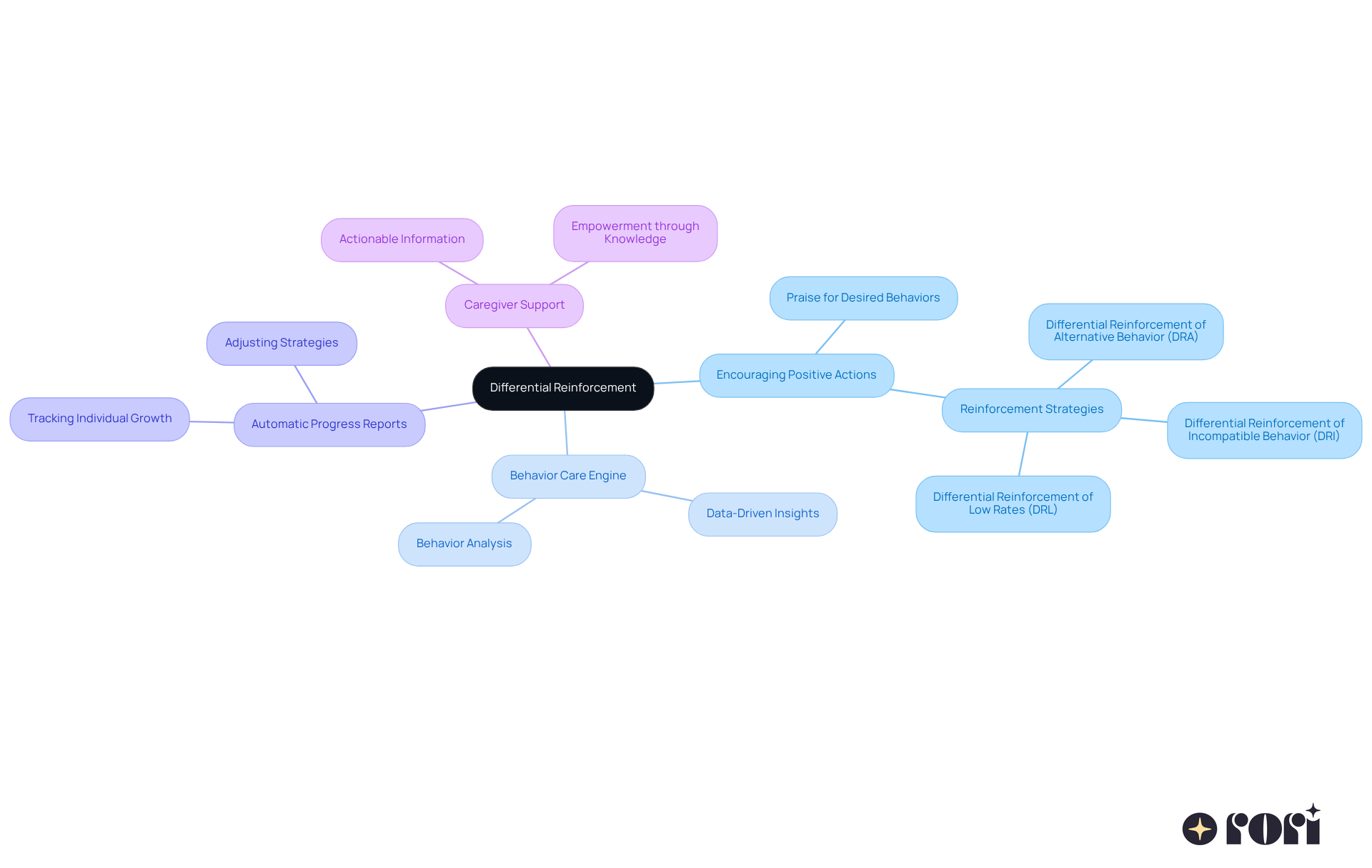
Social reinforcement is such a powerful tool! It employs positive social interactions, like high-fives, hugs, or even a simple word of praise, as behavioral reinforcement strategies for kids with ASD to encourage desired behaviors. Imagine a little one sharing a toy and then getting a big smile and some praise from a friend. Not only does that reinforce the sharing behavior, but it also helps them build those all-important social skills.
Research shows that kids involved in social skills groups really thrive. They get to practice conversational skills, turn-taking, and conflict resolution-skills that are crucial for effective social interaction. Isn’t that amazing?
Recent findings reveal that 78% of kids aged 6 months to 5 years show signs of thriving, which tells us that positive social interactions can really boost emotional resilience and overall well-being. Child psychologists often say that every behavior tells a story. Understanding what drives these actions can lead to more compassionate responses. One specialist beautifully put it, 'Discipline truly signifies teaching, not punishment.' This highlights how important it is to guide our kids with positive encouragement instead of just focusing on corrections.
New discoveries are shining a light on the effectiveness of social support techniques. Young people who take part in organized social skills therapy are often better equipped to handle social situations. By creating opportunities for positive interactions, caregivers can utilize behavioral reinforcement strategies for kids with ASD to help them build confidence and competence in their social skills. This ultimately leads to better behavior and stronger friendships with their peers.
Let’s explore this together! If you’re looking for ways to support your child, remember that you’re not alone. We’re here to help you every step of the way!
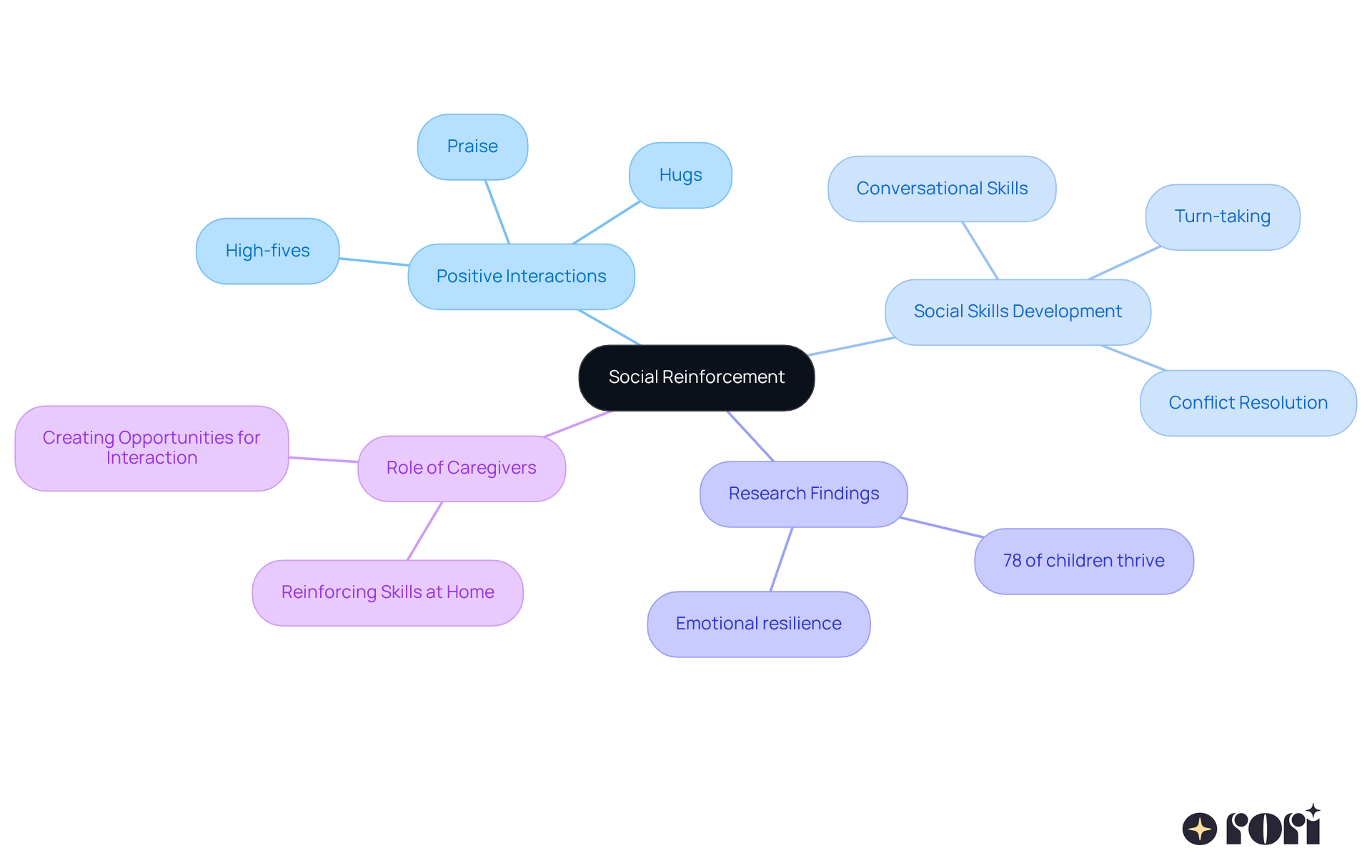
Natural reinforcement happens when a young person's actions lead to natural consequences, creating a clear link between what they do and what happens next. For example, when a child helps set the table and then gets to join the family for dinner, that act of helping is rewarded with the joy of being included in a family activity. This not only encourages positive behavior but also helps kids grasp the real-world outcomes of their actions.
Behavior specialists emphasize the significance of incorporating daily activities into behavioral reinforcement strategies for kids with asd. By using everyday tasks like chores or family meals, caregivers can give kids a chance to see the benefits of their positive actions. This approach builds a sense of belonging and responsibility, which are key for social growth.
Recent studies show just how effective natural support can be in autism treatment. When young people notice the immediate benefits of their actions, they’re more likely to repeat those behaviors. For instance, research suggests that getting kids involved in household activities can significantly boost their social skills and emotional understanding, as they learn to navigate social interactions in familiar environments.
You can see real-world applications of these natural encouragement strategies everywhere-from home to school. By incorporating behavioral reinforcement strategies for kids with asd into daily routines, caregivers and educators can create a nurturing environment that promotes positive behavior and supports kids in thriving socially and emotionally.
Let’s explore this together! We’re here to help you every step of the way!
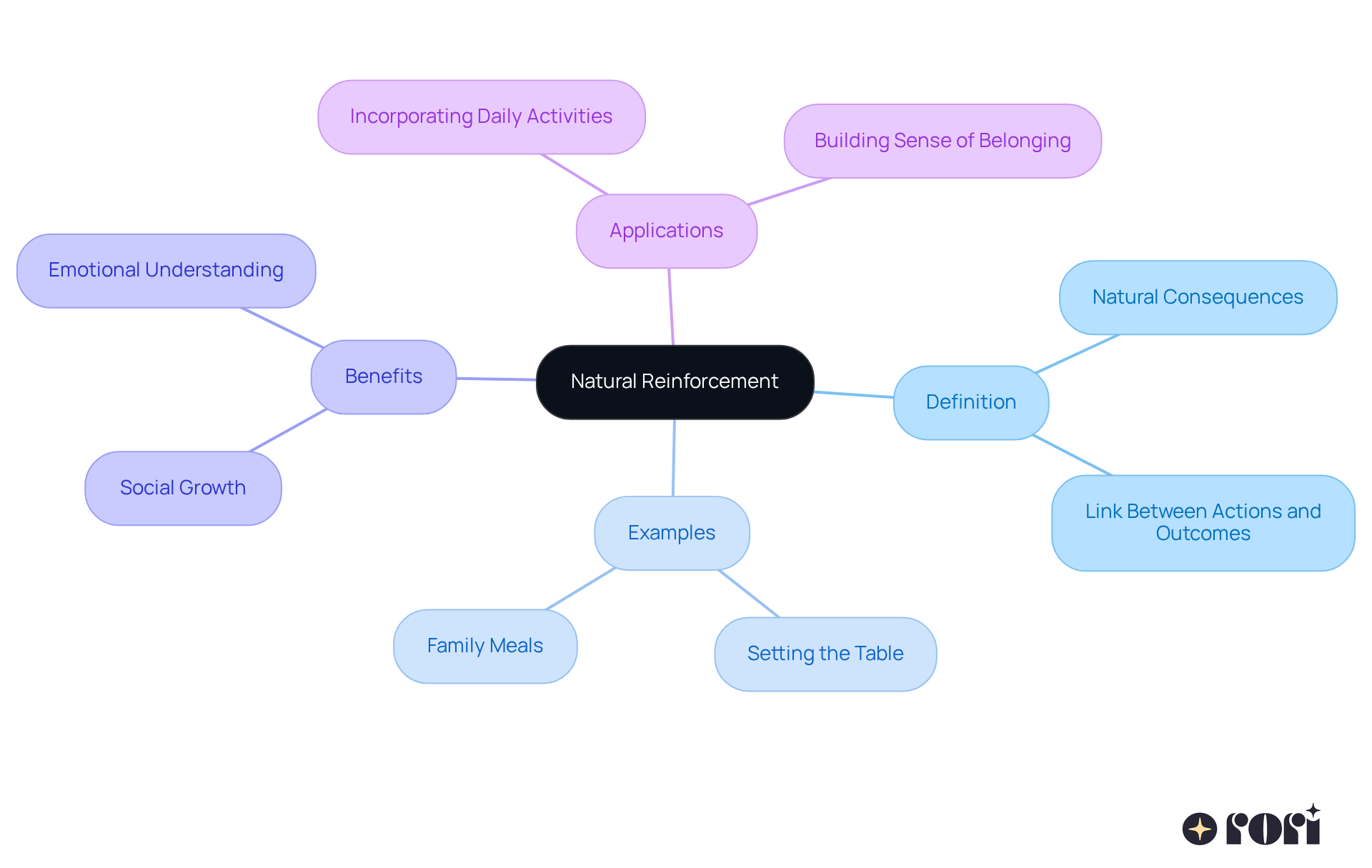
When it comes to encouraging our kids, consistency is key! It’s all about applying the same rules and rewards in different places. For example, if your child gets a pat on the back for using polite words at home, they should receive that same cheer at school. This kind of consistency helps them understand what’s expected and makes learning stick, leading to better behavior over time.
At Rori Care, we believe in empowering parents with behavioral reinforcement strategies for kids with asd, including:
This way, you’re equipped to provide the right support at home, which beautifully complements any professional help your child might be receiving. Feeling informed boosts your confidence and reduces stress, and that’s a win-win for everyone!
So, let’s explore this together! We’re here to help you every step of the way!

Progress monitoring is so important for understanding how a child is developing and how effective the support techniques in Applied Behavior Analysis (ABA) therapy are. This systematic approach involves keeping a close eye on specific behaviors, noting when reinforcement is used, and tracking changes over time. For instance, using techniques like Frequency Recording can help caregivers count how often a behavior occurs, while Duration Recording looks at how long a behavior lasts. These methods provide solid evidence of progress and help caregivers see which strategies work best.
Research shows that young people who receive consistent, high-frequency ABA therapy - typically 25 to 40 hours a week - tend to show greater improvements in adaptive skills and communication. One study with 582 clients found significant gains in communication, social skills, motor skills, and daily living abilities after just 12 months of treatment. This really highlights how crucial regular assessments and data collection are.
Clinicians often point out that when families actively participate in tracking behavior changes, it boosts the effectiveness of therapy. By getting families involved in the data collection process, therapists can tailor their approaches to meet each child’s unique needs. This creates a collaborative environment that supports progress both in therapy and at home. Plus, ongoing data monitoring allows for quick adjustments to treatment plans, ensuring they stay in tune with the child’s evolving needs.
In summary, effective progress tracking utilizes behavioral reinforcement strategies for kids with ASD to monitor behavior changes and evaluate the impact of support methods, leading to better outcomes. And with technology playing a role in data tracking, the accuracy and reliability of these assessments are even better, making it a key part of successful ABA therapy. Let’s explore this together!

Working together with specialists, especially Board Certified Analysts (BCBAs) at Rori Care, can really boost how effectively we support youth with autism. Our clinical leadership group, which includes amazing specialists like Dr. Jesslyn Nicole Farros, Ph.D., BCBA-D, has been focusing on ABA for Pervasive Developmental Disorders since January 2013. They bring invaluable knowledge to the table, helping create personalized action plans that cater to each child's unique needs.
For instance, they might suggest specific support techniques that resonate with a child's interests and motivations. This way, we ensure a more effective approach to implementing behavioral reinforcement strategies for kids with asd in behavior management. Research shows that when parents actively collaborate with BCBAs, the consistency and effectiveness of behavioral reinforcement strategies for kids with asd improve, resulting in better outcomes.
We've seen successful examples where our BCBAs have worked closely with families to implement behavioral reinforcement strategies for kids with asd, resulting in significant behavioral improvements. This partnership not only empowers parents but also fosters a supportive atmosphere that's essential for the child's development. Let’s explore this together! We’re here to help you every step of the way!
Balancing positive and negative incentives is key to effectively managing behavioral reinforcement strategies for kids with asd. Think about it: positive encouragement, like rewarding preferred actions, really helps motivate young ones to join in on constructive activities. On the flip side, negative conditioning can help reduce unwanted behaviors by removing unpleasant stimuli when the preferred action happens. For example, a child might finish their homework to avoid losing playtime. This shows how negative encouragement can lead to compliance.
Recent studies have found that mixing both behavioral reinforcement strategies for kids with asd and support techniques can lead to better outcomes, covering a wider range of actions and encouraging long-term skill growth. When used wisely, effective applications of behavioral reinforcement strategies for kids with asd, including both negative reinforcement and positive methods, can significantly improve behavior management. Behavior analysts stress the importance of carefully implementing these techniques to promote positive habits without creating a reliance on external rewards.
By understanding and applying behavioral reinforcement strategies for kids with asd, caregivers can foster a supportive environment that encourages growth and independence. Let’s explore this together! We’re here to help you every step of the way!
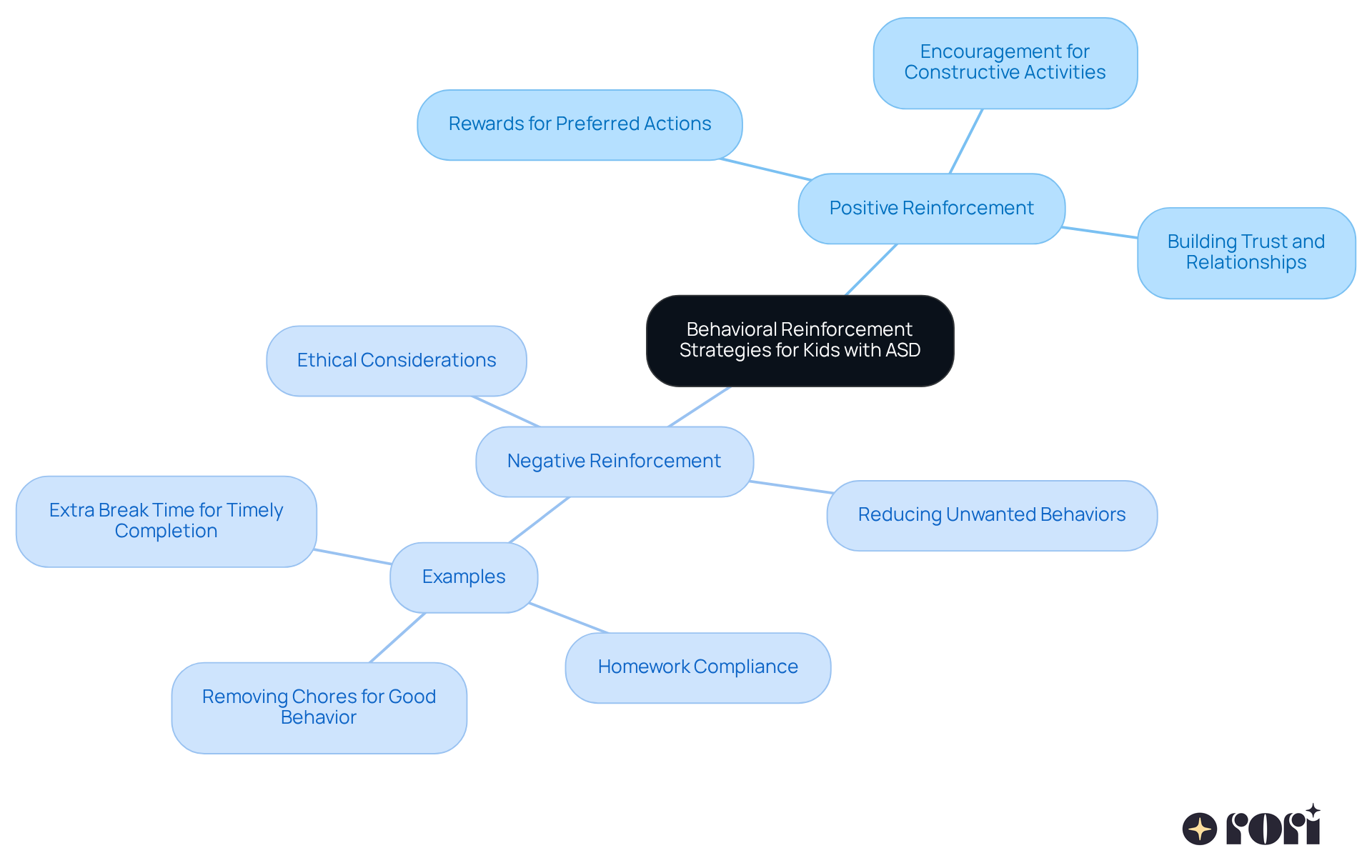
Exploring effective behavioral reinforcement strategies for children with Autism Spectrum Disorder (ASD) can be a game-changer for families. Personalized approaches really make a difference in encouraging positive behavior and skill development. By using tailored techniques like positive reinforcement, token economies, and social reinforcement, caregivers can create warm environments where children can truly thrive, both socially and emotionally.
It’s important to remember that consistency is key! Keeping reinforcement practices steady, monitoring progress, and collaborating with behavior specialists can really enhance the experience. Each strategy, from differential reinforcement to natural consequences, helps children understand their actions and the rewards or consequences that follow. When caregivers get involved, it amplifies the effectiveness of these strategies, ensuring kids receive the support they need in various settings.
Ultimately, implementing these behavioral reinforcement strategies not only helps children with ASD develop essential skills but also enriches family life. Watching your child grow and gain independence is such a rewarding journey! Embracing these methods can lead to wonderful improvements in communication, social skills, and overall well-being. So, let’s stay informed and actively participate in our children’s development together. The combined efforts of families and professionals can truly create transformative outcomes for children with ASD. We’re here to help you every step of the way!
What is Rori Care's approach to ABA therapy for children with ASD?
Rori Care utilizes a data-driven approach to Applied Behavior Analysis (ABA) therapy, crafting customized treatment plans through thorough assessments to meet the individual needs of each child with ASD.
How does personalized ABA therapy benefit children with ASD?
Personalized ABA therapy enhances children's ability to handle social situations, fosters greater independence, and promotes integration into their communities. Early and consistent intervention can lead to significant improvements in communication and adaptive behaviors.
What role do caregivers play in the ABA therapy process?
Caregiver participation is crucial in the therapy process, and education for caregivers is emphasized to promote substantial advancements in the child's development.
What are positive reinforcement techniques in the context of ABA therapy?
Positive reinforcement techniques involve celebrating small victories by rewarding children for desired behaviors, such as sharing toys, with instant rewards like verbal praise or tokens, which helps boost their self-esteem and motivation.
How does a token economy system work for managing positive behavior in kids with ASD?
A token economy system rewards children with tokens for displaying desired behaviors, which they can later exchange for fun rewards. This method promotes good behavior while teaching delayed gratification.
What evidence supports the effectiveness of a token economy system?
Research shows that behavioral scores improved significantly in children after implementing a token economy system, demonstrating its effectiveness in encouraging positive behavior and understanding expectations and consequences.
What is the importance of caregiver involvement in behavioral reinforcement strategies?
Active caregiver involvement, along with careful data collection, significantly enhances the effectiveness of behavioral reinforcement strategies for children with ASD, leading to improved emotional and social development.